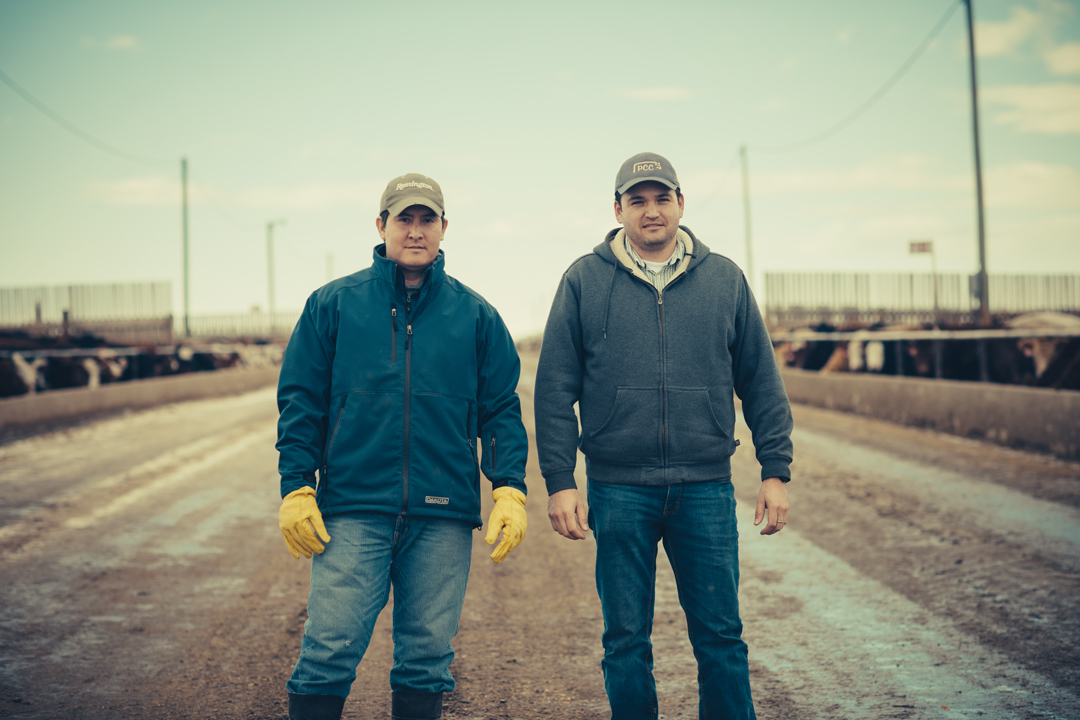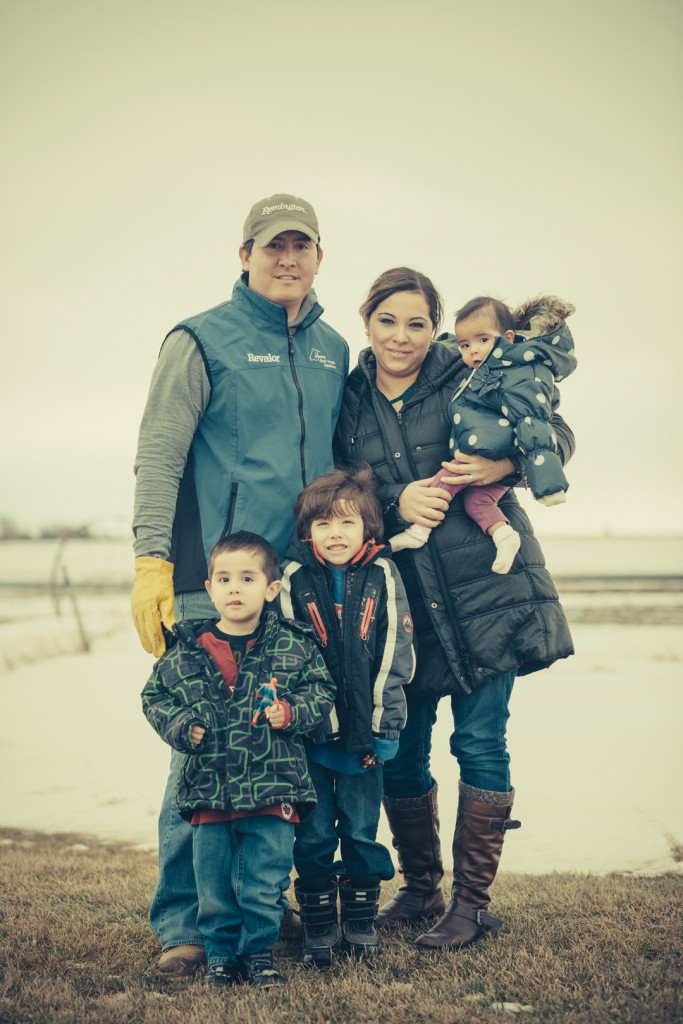CHANGING THE RULES
FEELING THE PAIN OF CANADA’S TEMPORARY FOREIGN WORKERS
BY SCOTT ROLLANS
Cristo Hurtado remembers his first visit to Southern Alberta’s Paskal Cattle Company in 2006. The young veterinarian had travelled from his home in Monterrey, Mexico, to explore the possibility of pursuing a new life in Canada as a temporary foreign worker.
“We came in May,” recalled Hurtado. “It wasn’t green yet, but there was no snow at all. [Company president] Rick Paskal told me, ‘All this is going to be white in winter.’ I couldn’t even picture that in my head.”
Nine years (and nine Canadian winters) later, that snowy landscape has become home to Hurtado, his wife and their two young sons (the younger one born in Lethbridge). This past May, the family made the final step in their transition by becoming Canadian citizens. In the meantime, Hurtado has risen to the position of Paskal’s general manager in charge of grain buying.
It’s a familiar story on the Canadian Prairies. In recent years, temporary foreign workers have played an ever more prominent role in the labour market, including the agricultural sector. But recent changes to Canada’s Temporary Foreign Worker Program (TFWP) may turn stories like Hurtado’s into the exception rather than the rule.
When Hurtado came to Alberta, he left behind a steady job with a Monterrey food processor. His girlfriend (now his wife) had been living in Manitoba with a Canadian friend and regularly coaxed him to follow her lead.
One day, when a delegation of Canadian farmers visited the processing plant in Monterrey, an understanding boss tagged Hurtado to give them a tour.“ He knew I was exploring this option.” The group included Paskal. At the end of the visit, Hurtado gathered his courage and told Paskal he had been considering a move to Canada. “Rick said, ‘Give me a call and we’ll talk.’”
In the months that followed, Hurtado took Paskal at his word, peppering him with endless questions about life in Alberta.
“I asked him about the schools. I asked him if you could buy peppers there. I asked him how much meat costs. I guess Rick got sick of my questions. He said, ‘Just come and visit, and see it for yourself.’”
Over the duration of his initial two-year TFWP permit, Hurtado had enough time to work his way through the bureaucratic hoops and achieve permanent resident status. Future foreign workers may not be so lucky.
On June 20, 2014, the federal government announced significant changes to the TFWP, promising “a balanced set of reforms to ensure that employers put Canadian workers first.” Major changes included an increase in the Labour Market Impact Assessment fee paid by employers, to $1,000 from $275 for every requested temporary foreign worker position; caps on the percentage of “low wage” temporary foreign workers an employer may hire (“low wage” being interpreted as any wage falling below the provincial median); and a reduction in the duration of work permits, to one year from two years
(full details at www.esdc.gc.ca/eng/jobs/foreign_workers).
In February, news broke that the federal government had introduced bridging measures for TFWs who came to Canada in 2011 or earlier. This is a one-year extension for TFWs seeking permanent residency in the province through the Alberta Immigrant Nominee Program. In certain instances, those applications can take up to two years to process.
Asked if he would make the jump to Canada in today’s circumstances, Hurtado didn’t hesitate.
“I had a good job in Mexico and I had just bought a house. It wouldn’t have been worth it financially to come and just explore for a year.”
Eduardo Gomez, a more recent immigrant and Hurtado’s colleague at Paskal, finds himself caught in the shifting regulatory landscape. Gomez knew Hurtado from Monterrey, having attended the same veterinary school a couple of years behind him, and hoped to follow the same path to Canada. His dream hit a snag last year when he was called into a meeting at Paskal’s office and learned that the TFWP changes might affect him and his family.
Since then, Gomez has made progress in his paperwork.
“Things are going better,” he said. “But my wife and I were scared. We didn’t know what we were going to do if the government sent us back to Mexico.”
Gomez’s boss, Paskal, would be as sorry as anyone to see the young veterinarian sent back home. Over the years, Paskal has brought in around 50 temporary foreign workers to help staff his various operations, including a cattle feedlot with a 65,000-head capacity. Of those, all but one has stayed in Canada.
Paskal insisted the TFWP is essential to his thriving businesses.
“It’s absolutely everything,” he said. “The people we’ve brought up are agricultural people. Most of them come out of Mexico. They’re university educated; a lot of them are veterinarians. They’re willing to work in agriculture. They see this as their employment for years to come. They’re not looking, the minute they get here, for a high-paying job in the oil business. They’re of huge value to the agricultural economy in Canada.”
Paskal bristled at the suggestion that companies like his use foreign workers to avoid paying proper wages.
“We treat them the same as Canadian domestic employees. There’s no difference. They have the same entitlements to health care, to benefit programs, to bonuses. Everyone is treated the same here.
“It’s not that they’re cheaper—that’s not the issue here,” he said. “They’re committed to being in agriculture.”
Paskal insisted his company does everything it can to attract workers from within Canada. He described one recruiting drive that took him to Port Hawkesbury in Nova Scotia.
“Not one person showed up at the job fair,” he said. “Not one. And they’ve got 18 per cent unemployment there.”
With the tightening of the TFWP, Paskal doesn’t believe Canadian workers will fill the void.
“I can try to pay them a competitive wage that keeps me in business,” he said, “but I can’t hold a gun to their head and make them move. So, then, what am I supposed to do? As I sit here today, we’re 10 or 15 people short.”
While Paskal frets about his company’s welfare, he also worries about the foreign employees who depend on him.
“They’re the backbone of my company. They’ve taught us a lot—they’ve taught us about the value of relationships, that people aren’t just numbers. It’s probably one of the best things I ever did in my life, to be honest with you, to bring foreign workers.”
Paskal Cattle is just one company, but its labour frustrations are echoed in the agriculture sector throughout the Prairies, said Portia MacDonald-Dewhirst, executive director of the Canadian Agricultural Human Resource Council (CAHRC). Domestic labour is in short supply these days, and most people who are looking for work aren’t looking at agriculture.
“Agriculture requires people to work in atypical positions,” she said. “It’s not a desk job within a building, with a nine-to-five kind of schedule. It’s physically demanding work, often in rural settings, with a 24/7 kind of operational schedule.”
In 2012, the CAHRC worked with the Agriculture and Agri-Food Value Chain Roundtable to launch a Labour Task Force to help craft strategies for dealing with labour shortages in the agriculture industry. In March 2014, the task force released its Agriculture and Agri-Food Labour Action Plan (www.cahrc-ccrha.ca/labour-action-plan), which calls for a twin strategy to increase the supply of labour while also improving the knowledge and skills of workers in the industry.
“The plan needs to be collaborative in its approach, and a partnership between industry and government. We need to work together on this,” said MacDonald-Dewhirst.
Recent changes to the TFWP—increased fees, shortened work permits, caps on numbers—haven’t helped, she said.
“Things were hard already, and now they’re even more difficult.”
She also sees people in the industry struggling to absorb the implications.
“They’re still trying to get their heads around it. Some elements have been communicated well, and others are still a little fuzzy in terms of how the plan will roll out and evolve.”
At the same time, MacDonald-Dewhirst would like to see better public awareness about the benefits Canada has seen through the TFWP.
“It’s a challenge when only the negative stories are published, because there are so many positive stories about the win-win nature of the program.”
Above all, said MacDonald-Dewhirst, time is of the essence.
“We’re already in shortage. What’s going to happen five years from now?”
MacDonald-Dewhirst would get no argument from Scott Entz, general manager of Cargill’s meat processing facility in High River, AB.
“We’re about 300 people short now,” he said.
Labour scarcity makes it impossible to carry on business as usual, Entz explained.
“The first thing you do is you work more overtime, which starts to impact our competitiveness because our costs are higher.”
Meanwhile, the company ends up having to reduce its emphasis on value-added products.
“When you bring an animal in, you have to process the entire carcass,” he said. “We can’t just put it back and wait until next week. If I don’t have enough people, I just have to do products that are simpler, so that I can still get the product through. The end result is we don’t collect as much value from that carcass.”
Entz estimated that Cargill has brought in 1,100 foreign workers to High River over the years, the vast majority of whom have become permanent residents or citizens.
“And if you annualize the turnover, we’re probably about six per cent for that group—which, for our industry, is just outstanding.”
Like Paskal, Entz values the commitment displayed by the foreign workers.
“This is a career for them. Just being honest, for most of the Canadian folks we hire, working on our operation isn’t necessarily a career for them.”
Al Dooley, labour recruitment specialist at Alberta Agriculture and Rural Development, agreed that agriculture can be a tough sell for potential employees.
“Young people have lots of options, and in some ways we should be happy about that,” he said.
Dooley doesn’t see the solution coming entirely from within Canada’s borders.
“If you get into economies like Alberta and Saskatchewan, where you’re approaching full employment, how will we deal with this? It’s a complicated issue, for sure.”
While everyone worries about the economic impact, many in the industry feel we should also spare a thought for the individuals most affected by changes to the TFWP: the workers themselves.
“These people come here, moving their whole families, with a really good work ethic,” said Bryan Walton, CEO of Alberta Cattle Feeders’ Association. “They come here to seek opportunities. They will help us sustain our rural communities in a time when we see the rural populations declining. If you look at it that way, we’re providing a service to the federal government. We’re not displacing Canadians.”
In return, Walton believes we owe our foreign workers a fair shot at a new life.
“The insinuation that these people came here knowing it was temporary is disingenuous,” he said. In his view, we shouldn’t bring people to Canada under one set of assumptions and then change the rules and send them packing.
“That is uncivil. This is the human side of the story, and it’s uncivil what’s happening. That should not happen in our country.”
Nevertheless, Paskal said companies are being forced to do just that. Processors who are already short of bodies are having to send people home in order to comply with new caps on foreign workers, he claimed.
“We’re the political pawn in the centre here. And our government is going to force good, legitimate businesses out of this country. I can’t think of another word for it but ‘bull—.’”
In the meantime, Hurtado and Gomez are hopeful for their families’ future, and grateful for the opportunities they’ve had through the TFWP. With every passing month, said Hurtado, Alberta feels more like home. He has even joined the Rotary Club, although he admittedly doesn’t make every meeting.
“I wish I had more time and I was a better Rotarian,” he said.
Gomez and his wife have two sons, and a young daughter born in Canada.
“My eldest kid is playing hockey—we don’t have that in Mexico,” he laughed. “I was a coach last year of football—sorry, soccer! We’re trying to get involved in the community, to feel like this is our home.”
He’s also struggling to remain patient as he navigates his way towards permanent residency.
“Every country has their own rules,” he observed ruefully, “but some rules are changing every six months.”
Gomez is also proud of the value he has brought to Paskal Cattle.
“Each time that I see Rick Paskal, I tell him, ‘Thank you.’ And he says, ‘No—thank you.’”










Comments